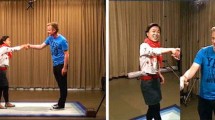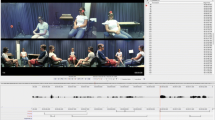Abstract
Communicative feedback refers to unobtrusive (usually short) vocal or bodily expressions whereby a recipient of information can inform a contributor of information about whether he/she is able and willing to communicate, perceive the information, and understand the information. This paper provides a theory for embodied communicative feedback, describing the different dimensions and features involved. It also provides a corpus analysis part, describing a first data coding and analysis method geared to find the features postulated by the theory. The corpus analysis part describes different methods and statistical procedures and discusses their applicability and the possible insights gained with these methods.






Similar content being viewed by others
References
Allwood, J. (1976). Linguistic communication as action and cooperation. Gothenburg monographs in linguistics 2. Göteborg University, Department of Linguistics.
Allwood, J. (2000). Structure of dialog. In M. Taylor, D. Bouwhuis, & F. Neel (Eds.), The structure of multimodal dialogue II (pp. 3–24). Amsterdam: Benjamins.
Allwood, J., Cerrato, L., Dybjær, L., Jokinen, K., Navaretta, C., & Paggio, P. (2005). The MUMIN Multimodal Coding Scheme. NorFA Yearbook 2005.
Allwood, J., NivreJ., & Ahlsén, E. (1992). On the semantics and pragmatics of linguistic feedback. Journal of Semantics, 9(1), 1–26.
Bakeman, R., & Quera, V. (1995). Analyzing interaction: Sequential analysis with SDIS and GSEQ. New York: Cambridge University Press.
Grammer K., Honda R., Schmitt A., & Jütte A. (1999). Fuzziness of nonverbal courtship communication. Unblurred by motion energy detection. Journal of Personality and Social Psychology, 77(3), 487–508.
Grammer K., Kruck K., Juette A., & Fink B. (2000): Non-verbal behavior as courtship signals: The role of control and choice in selecting partners. Evolution and Human Behavior, 21, 371–390.
Kopp, S., Gesellensetter, L., Krämer, N., & Wachsmuth, I. (2005): A conversational agents as museum guide: design and evaluation of a real-world application. In Panayiotopoulos et al. (Eds.) Intelligent Virtual Agents, LNAI 3661 (pp. 329–343). Berlin: Springer-Verlag.
Kopp, S., Allwood, J., Grammer, K., Ahlsen, E., & Stocksmeier, T. (2008): Modeling Embodied Feedback With Virtual Humans. In I. Wachsmuth & G. Knoblich (Eds.), Modeling embodied communication in robots and virtual humans, LNAI 4930. Springer-Verlag.
Magnusson, M. S. (1996). Hidden real-time patterns in intra- and inter-individual behavior: description and detection. European Journal of Psychology Assessment, 12, 112–123.
Magnusson, M. S. (2000). Discovering hidden time patterns in behavior: T-patterns and their detection. Behavior Research Methods and Instrumentation, 32, 93–110.
Peirce, C. S. (1931). In C. Hartshorne, P. Weiss & A. Burks (Eds.), Collected Papers of Charles Sanders Peirce, 1931–1958, 8 vols. Cambridge, Mass.: Harvard University Press.
Popper, K. (1959). The logic of scientific discovery (trans. Logik der Forschung). London: Hutchinson.
Scherer, K. T. (1999). Appraisal theory. In T. Dalgleish & M. J. Power (Eds.), Handbook of emotion and cognition (pp. 637–663). Chichester: New York.
Ward, N., & Tsukahara, W. (2000). Prosodic features which cue back-channel responses in English and Japanese. Journal of Pragmatics, 32, 1177–1207.
Wiener, N. (1948). Cybernetics or control and communication in the animal and the machine. MIT Press.
Acknowledgements
We thank the Ludwig Boltzmann Institute for Urban Ethology in Vienna for help with data collection and transcription, the Department of Linguistics and SSKKII Center for Cognitive Science, Göteborg University, and the ZiF Center of Interdisciplinary Research in Bielefeld/Germany.
Author information
Authors and Affiliations
Corresponding author
Rights and permissions
About this article
Cite this article
Allwood, J., Kopp, S., Grammer, K. et al. The analysis of embodied communicative feedback in multimodal corpora: a prerequisite for behavior simulation. Lang Resources & Evaluation 41, 255–272 (2007). https://doi.org/10.1007/s10579-007-9056-2
Received:
Accepted:
Published:
Issue Date:
DOI: https://doi.org/10.1007/s10579-007-9056-2




